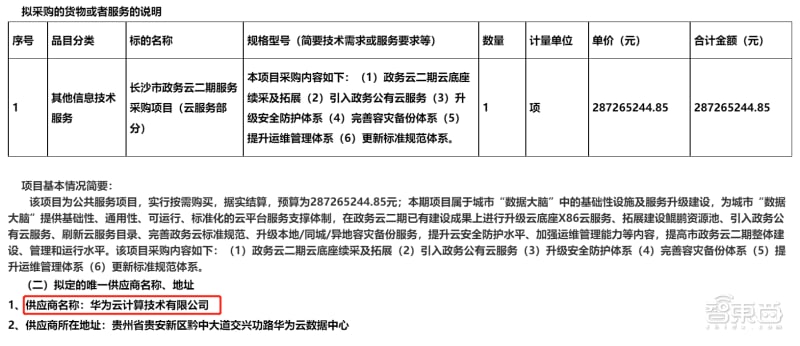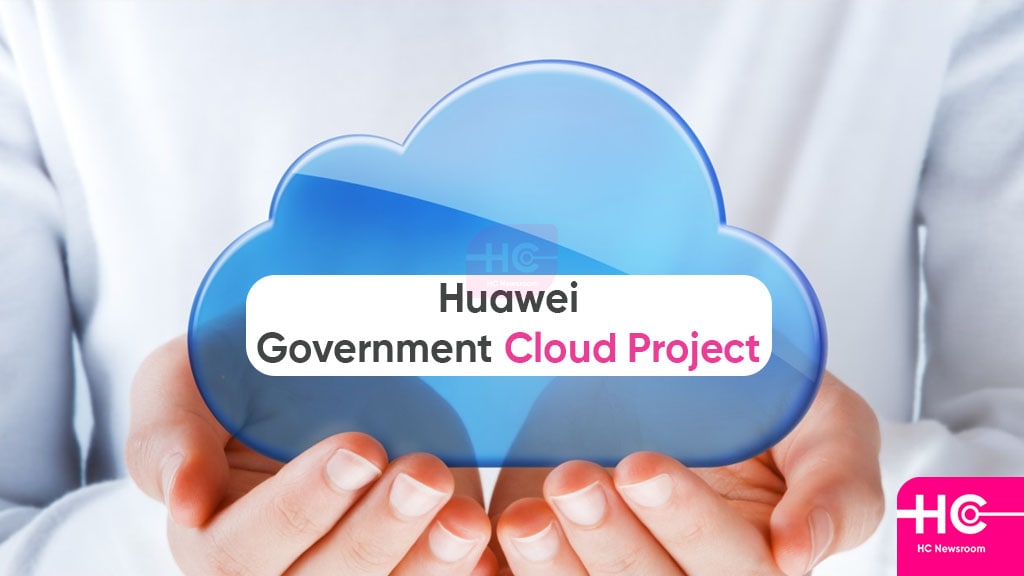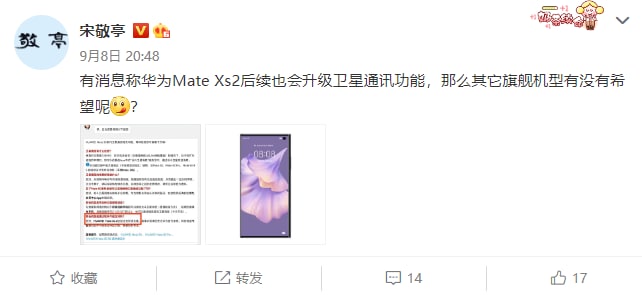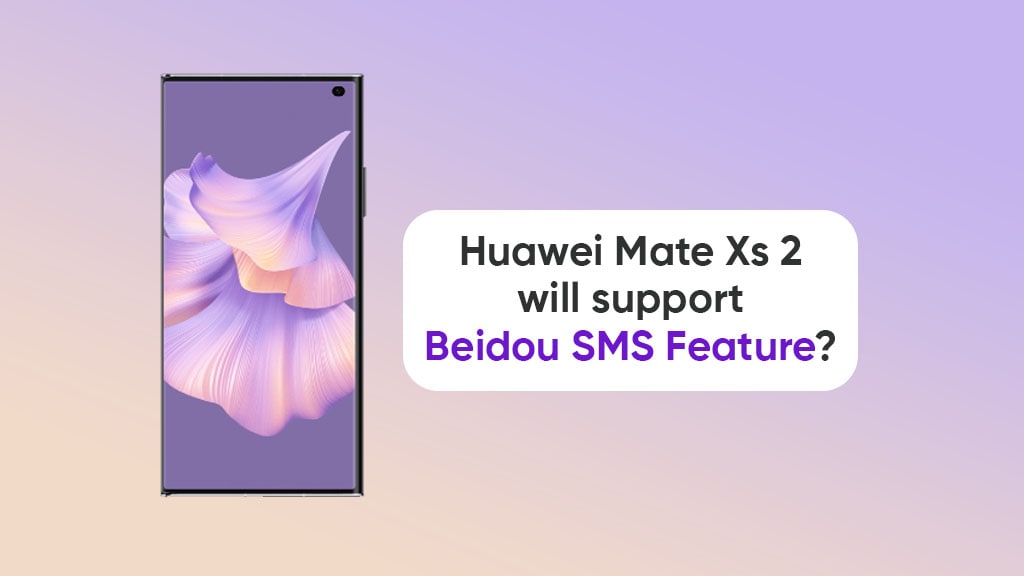Huawei HarmonyOS September 2022: Monthly and Quarterly Devices
HarmonyOS 3.0 round 2 beta adaptation begins for Huawei Mate 30, P40, Nova 10 and other devices
Chinese tablet maker qualifies OpenHarmony compatibility certification
Check out Huawei HarmonyOS September 2022 security patch details
Honor HarmonyOS 3.0 roadmap and eligible devices
Huawei Mate 50 5G case to launch in October
Check out the Huawei Mate 50 emergency battery mode
iPhone 14 Pro Max is 31g heavier than the Mate 50 Pro
Second-hand Huawei Mate 40 price hikes after Mate 50 launch
Huawei Mate 50 with Snapdragon 8+ scores 1 million Points on AnTuTu
Huawei Mate 20 Lite EMUI 12 out in UK
Huawei Mate 10 Pro EMUI 12 update is expanding in South Africa
Huawei Watch 3 series grabs lots of new features with September 2022 update
Huawei P50 Pro August 2022 firmware update is expanding
HarmonyOS 3 new beta is now available for Huawei MatePad Pro 10.8
Huawei Petal Travel beta released in China
Huawei AppGallery welcomes popular MIR4 game with attractive prizes in Philippines
Huawei Petal Maps to bring new features with Mate 50 series
Huawei NFC phone users gets ‘0 yuan’ purchase for UnionPay QuickPass
September 2022 Google Play System Update supports Google Kids Space functions
Huawei launches the new MateStation S desktop, inherits the first Super Device feature
Huawei MatePad Paper Ink Tablet Collector Edition launched with LTE connection
Huawei MateBook E Go notebook launched with Windows 11 and Snapdragon 8cx Gen 3 processor
Huawei could launch new MatePad Paper ink tablet on Mate 50 series event
Huawei MateBook E Go with Windows 11 will launch on September 6
Huawei Watch 3 series introduces AutoNavi Map Taxi feature
Huawei Watch 3 series grabs lots of new features with September 2022 update
Huawei Watch GT 3 Pro Titanium Strap Version sale is live!
Huawei Watch GT 3 Pro Titanium Edition launched
Huawei Watch 3 continues to add new features with HarmonyOS 3 beta 2 update
Published
on
By
Huawei has recently obtained a huge government cloud order worth 287 million yuan [4.19 million USD]. The Changsha Municipal Affairs has announced the Cloud Phase 2 service procurement project. Seeing Huawei as the right candidate, the organization has handed over the order with open-source procurement methods.
Huawei Cloud is one of the reflective tools for government officials as well as enterprise consumers. The Chinese manufacturer persistently improves the cloud infrastructure so that individuals can get benefits over time.
Since the new forces of Huawei have highly influenced the Internet cloud computing sectors, government officials have decided to pass on the biggest cloud order to the company, with a massive budget and other requirements.
It’s not the first time that the government has made Huawei solely in charge of the cloud project. Earlier on July 4, the government declared Huawei as the manager of the 2022-2025 service project in Changping District worth 190 billion yuan [27.7 billion USD]. The Municipal officials believe that since this project needs upgrading and improvement in the existence of IaaS services, the addition of new databases, cloud-native, AI, and other PaaS layer services, Huawei would be the best selective.
Notably, both the above-mentioned projects are single-source procurement. As a result, except for Huawei, no other cloud firms such as Alibaba Cloud and Tencent Cloud can participate in this framework. Speaking of the new project, the information reveals that this is going to be an effective project. By 2023, the revenue of this project will make 149.73 billion yuan [21.8 billion USD]. 
Why Huawei is constantly getting new cloud projects?
Unlike other cloud institutes, Huawei Cloud covers most of the aspects that computing technology requires. For instance, IaaS, PaaS, and other levels. Besides, Huawei is the one and only distributor of key technical support, unified security management, unified operations, and maintenance.
On the flip side, Changsha Municipal Affairs assigned Huawei to be the single-source procurement supplier in June 2019. Consequently, the contract is valid for three years and is still stable and safe. Hence, it is logical for Huawei to continue the project.
Another significant point is that this cloud project confines some confidentiality information and security-related subjects. Hence, due to data security and other reasons, the government only allows specific manufacturers can drive to the end level.
Although, there are three types of cloud organizations residing in the market at present. However, the government mainly selects the institutes that can serve the security as well as performance equally. In these aspects, Huawei stands at the top position. 
(Source)
Huawei Mate 50 real device spy photo reveals camera details
Huawei introduces 120 digital talents in Seeds for Future Program
Yash is a graduate of computer science and followed his way into journalism, he is interested in various subjects related to technologies and politics. Yash likes to listen classical songs and has a huge library of classical mixes.
Huawei HarmonyOS September 2022: Monthly and Quarterly Devices
Huawei Mate 20 Lite EMUI 12 out in UK
U.S. to ease Huawei sanctions, scared of losing lead in technology?
Published
on
By
Yes, it’s interesting news that just broke out, the U.S. has revised the plans to transfer important technologies to restricted companies including Huawei. This may lead us to ease U.S. sanctions posted on Huawei.
So, what does it actually means for the company and for everyone, and is this a result of the fear that is now haunting the U.S.?
According to Bloomberg, The U.S. Commerce Department has decided to come up with some so-called new “standards” which would allow even restricted companies to access U.S.-made technologies. However, there’s a direct catch, that these companies must have to obey what these standards decided by the commerce department.
What are these standards? It says, that the company will have to engage in a conversation with the commerce body to get further clarification on this matter.
“US stakeholders need to be fully engaged in international standards organizations, particularly where the critical but sometimes invisible standards that they set have important national security as well as commercial implications,” Alan Estevez, the Commerce undersecretary for industry and security, said in the statement.
“Today’s rule provides much-needed clarification to US industry and other organizations that will allow for continued US leadership in these critical bodies.”
Scared?
In 2019, Huawei has been included in the Entity List, a program to ban Huawei from accessing or selling technology to the U.S. market. That has brought a big lack of accessing new components and technologies to make new products.
One such example includes the ousting of Google Mobile Services (GMS) and another includes chipsets for both mobiles and ICT business.
The entire scenario has affected greatly Huawei and its subsidiaries. The revenue decline so does its market share in different categories of products.
Still, the company has decided to keep up and make new products with what it has in hand. Such an example could be seen in the sharing of patent technologies to generate extra revenue and make good use of existing stocks.
Meanwhile, Huawei continues to dig deep into new technologies and this could be clearly seen in advancements such as Satellite Calling, yes, it’s a new kind of advancement that has brought this Chinese company to fight head to head with Apple. Not even Samsung could do that but Huawei did.
On the other hand, Huawei keeps on looking for new ways to get chipsets or investing in companies that could advance in chipset precision technologies.
Yes! The U.S. doesn’t want to lose its lead over the technological world and for that, the best way is to open access to required technologies for all of the restricted firms. Another aspect is, that these firms bring a large share of income and revenue, as their absence causes big trouble for their business partner in the U.S, and the ease of Huawei sanctions might help big on this matter.
Which technologies?
Currently, the commerce department has not announced the list of technologies that will be shared with Huawei but we’ll keep you posted with any further remarks on this matter.
Published
on
By
Today, Canalys has released a new report regarding the cloud infrastructure of China. While the overall China cloud market has seen a downfall of 20 percent, Huawei still managed to survive and positioned itself in the top four vendors list in the cloud computing sector.
The latest reports suggest that the cloud infrastructure expenditure of China has crossed over 7.3 billion USD in the second quarter of this year. Ultimately, this is one of the main reasons behind the decline of the cloud computing market.
Besides, this 7.3 billion USD also counts for 12 percent of the overall global clouding expense. As a result, the growth of the Chinese market suddenly slowed down and came below 20 percent of the actual growth rate of the region.
Notably, this is for the first time that China has seen such a low market in its native area. Though, there is a hike of 33 percent in the growth momentum of the global cloud service market. Yet, a loss is a loss, whether it’s in the global merchandise or the native place.

Huawei cloud computing still surfing at heights in China!
Though the China market has stuck in a declining state. Regardless, four top vendors managed and maintained their leadership in the cloud computing market till the end. These include Huawei Cloud, Tencent Cloud, Baidu Smart Cloud, and Alibaba Cloud.
Alibaba Cloud’s market share reached 34 percent, with an increase of 10% and a market share drop of 2 percent. On the other hand, Huawei came up as the second-largest cloud merchandiser with 11 percent of growth year-on-year and made a share of 19 percent in the overall market.
Next, we have Tencent cloud ranking at the third position with 17 percent of China’s cloud computing market. And the fourth is Baidu Smart with 9 percent of the market share and 25 percent growth on yearly basis.
Together, these companies have accounted for 79 percent of the total spending in China. In comparison to previous quarters, these outcomes are low. Yet, it’s always good to have something than nothing!
(Source)
Published
on
By
As per the recent reports, Huawei Mate Xs 2 foldable phone could be the next to use the satellite communication feature by Beidou. According to Huawei, the latest Mate 50 series is the first to support this feature.
Beidou communication is an emerging wireless technology and its biggest feature is its SMS service. It’s a unique invention of China’s Beidou satellite navigation system and a major advantage.
It allows users to send short messages and locations via the Beidou satellite messages even when they are in an area without network connectivity. This feature also adds navigational tools for traveling.
The company has described this technology as “pierce the sky upwards”.

The other models could not use this function through software upgrades. Although, mobile phones from other brands can get Beidou messages in the regions without cellular services.
Also, Huawei Mate Xs 2 being a prominent foldable phone could get this satellite communication function in the future.
Why Huawei Mate Xs 2 should get this function?
It is the latest foldable phone by Huawei. Also, it is the first to use tri-band Wi-Fi. As it is based on tri-band WiFi connectivity you can easily carry out the heaviest network tasks with the phone.
The tri-band routers support three separate bands that include two 5GHz frequency bands and one 2.4GHz frequency band. In simple words, it’s like having 3 separate networks in a single phone.
This could be the main reason for Huawei Mate Xs 2 to support the Beidou satellite communication feature. 
The other specifications of the phone:
The phone features a 7.0-inch large and foldable OLED display with 2200 x 2480 resolutions.
The dimensions of the device when folded are 156.5 x 75.5 x11.1 mm while when unfolded it is 156.5 x 139.3 x 5.4 mm.
It is powered by the Qualcomm SM8350 Snapdragon 888 4G Octa-core processor. Further, the camera on the rear side consists of a 50 MP main camera with an 8 MP telephoto camera and a 13 MP ultrawide camera. While on the front side it has a 10.7 MP selfie camera.
The Mate Xs 2 is fueled by a 4600 mAh battery with a fast charging capacity of 66W. The phone comes in two storage types- 8GB + 256GB and 12GB + 512GB.
The phone is available in three colors, Black, White, and Purple.
(Source)
Copyright © 2022 Huaweicentral.com